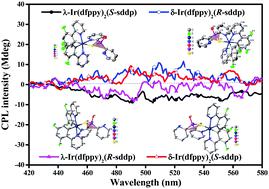当前位置:
X-MOL 学术
›
J. Mater. Chem. C
›
论文详情
Our official English website, www.x-mol.net, welcomes your
feedback! (Note: you will need to create a separate account there.)
Pyridinylphosphorothioate-based blue iridium(III) complex with double chiral centers for circularly polarized electroluminescence
Journal of Materials Chemistry C ( IF 5.7 ) Pub Date : 2021-3-22 , DOI: 10.1039/d1tc00832c Jun-Jian Lu 1, 2, 3, 4, 5 , Zhen-Long Tu 1, 2, 3, 4, 5 , Xu-Feng Luo 1, 2, 3, 4, 5 , Yi-Pin Zhang 1, 2, 3, 4, 5 , Zhong-Ze Qu 1, 2, 3, 4, 5 , Xiao Liang 1, 2, 3, 4, 5 , Zheng-Guang Wu 6, 7, 8, 9, 10 , You-Xuan Zheng 1, 2, 3, 4, 5
Journal of Materials Chemistry C ( IF 5.7 ) Pub Date : 2021-3-22 , DOI: 10.1039/d1tc00832c Jun-Jian Lu 1, 2, 3, 4, 5 , Zhen-Long Tu 1, 2, 3, 4, 5 , Xu-Feng Luo 1, 2, 3, 4, 5 , Yi-Pin Zhang 1, 2, 3, 4, 5 , Zhong-Ze Qu 1, 2, 3, 4, 5 , Xiao Liang 1, 2, 3, 4, 5 , Zheng-Guang Wu 6, 7, 8, 9, 10 , You-Xuan Zheng 1, 2, 3, 4, 5
Affiliation

|
Circularly polarized organic light-emitting diodes (CP-OLEDs) have received considerable attention due to their promising applications in 3D displays. However, up to now, CP-OLEDs using iridium(III) phosphors as emissive dopants exhibited low brightness, insufficient efficiency, serious efficiency roll-off, and especially low electroluminescence dissymmetry factors (gEL). In this study, a blue Ir(III) complex Ir(dfppy)2(sdpp) (dfppy is 2-(2,4-difluorophenyl)pyridine, sdpp is pyridinylphosphorothioate) peaking at 466 nm was synthesized, and two pairs of enantiomers containing the λ or δ isomer together with a chiral phosphine center (R or S) were separated into λ-Ir(dfppy)2(S-sdpp), δ-Ir(dfppy)2(R-sdpp), λ-Ir(dfppy)2(R-sdpp) and δ-Ir(dfppy)2(S-sdpp), respectively. It is the first example to investigate phosphine chirality in an Ir(III) complex, and the electron cloud distribution in the chiral conjugated ancillary ligand and λ/δ chirality of the Ir(III) center induced Ir(dfppy)2(sdpp) to exhibit decent circularly polarized luminescence (CPL) activities with a dissymmetry factor (|gPL|) around 1.4 × 10−3. The OLEDs based on Ir(dfppy)2(sdpp) exhibited a maximum external quantum efficiency of 13.8% with mild efficiency roll-off. Notably, the CP-OLEDs based on λ-Ir(dfppy)2(S-sdpp), δ-Ir(dfppy)2(R-sdpp), λ-Ir(dfppy)2(R-sdpp) and δ-Ir(dfppy)2(S-sdpp) showed obvious circularly polarized electroluminescence (CPEL) signals with a gEL of −2.1 × 10−3, 2.4 × 10−3, −2.1 × 10−3 and 1.9 × 10−3, respectively, thus affording an efficient strategy for the design of chiral blue Ir(III) emitters and their CP-OLEDs.
中文翻译:

吡啶基硫代磷酸酯基蓝色铱(III)配合物,具有双手性中心,用于圆偏振电致发光
圆极化有机发光二极管(CP-OLED)由于在3D显示器中的应用前景广阔而备受关注。但是,到目前为止,使用铱(III)荧光粉作为发光掺杂剂的CP-OLED亮度低,效率不足,效率下降严重,尤其是电致发光不对称系数(g EL)较低。在这项研究中,合成了一个蓝色的Ir(III)络合物Ir(dfppy)2(sdpp)(dfppy是2-(2,4-二氟苯基)吡啶,sdpp是吡啶基硫代磷酸酯),并合成了两对含有λ或δ异构体以及手性膦中心(R或S)分为λ-Ir(dfppy)2(S -sdpp),δ-Ir(dfppy)2(R -sdpp),λ-Ir(dfppy)2(R -sdpp)和δ-Ir(dfppy)2(S -sdpp)。这是研究Ir(III)配合物中膦的手性,手性共轭辅助配体的电子云分布和Ir(III)中心诱导的Ir(dfppy)2(sdpp)的λ/δ手性的第一个例子。表现出良好的圆偏振发光(CPL)活动,且不对称因子(| g PL |)约为1.4×10 -3。基于Ir(dfppy)2(sdpp)的OLED显示出13.8%的最大外部量子效率,并具有适度的效率下降。值得注意的是,基于λ-Ir(dfppy)2(S -sdpp),δ-Ir(dfppy)2(R -sdpp),λ-Ir(dfppy)2(R -sdpp)和δ-Ir的CP-OLED (dfppy)2(小号-sdpp)表现出明显的圆偏振光致发光(CPEL)与信号克EL -2.1×10 -3,2.4×10 -3,×10 -2.1 -3和1.9×10 -3,分别,从而为手性蓝Ir()的设计提供了一种有效的策略。III)发射器及其CP-OLED。
更新日期:2021-04-06
中文翻译:

吡啶基硫代磷酸酯基蓝色铱(III)配合物,具有双手性中心,用于圆偏振电致发光
圆极化有机发光二极管(CP-OLED)由于在3D显示器中的应用前景广阔而备受关注。但是,到目前为止,使用铱(III)荧光粉作为发光掺杂剂的CP-OLED亮度低,效率不足,效率下降严重,尤其是电致发光不对称系数(g EL)较低。在这项研究中,合成了一个蓝色的Ir(III)络合物Ir(dfppy)2(sdpp)(dfppy是2-(2,4-二氟苯基)吡啶,sdpp是吡啶基硫代磷酸酯),并合成了两对含有λ或δ异构体以及手性膦中心(R或S)分为λ-Ir(dfppy)2(S -sdpp),δ-Ir(dfppy)2(R -sdpp),λ-Ir(dfppy)2(R -sdpp)和δ-Ir(dfppy)2(S -sdpp)。这是研究Ir(III)配合物中膦的手性,手性共轭辅助配体的电子云分布和Ir(III)中心诱导的Ir(dfppy)2(sdpp)的λ/δ手性的第一个例子。表现出良好的圆偏振发光(CPL)活动,且不对称因子(| g PL |)约为1.4×10 -3。基于Ir(dfppy)2(sdpp)的OLED显示出13.8%的最大外部量子效率,并具有适度的效率下降。值得注意的是,基于λ-Ir(dfppy)2(S -sdpp),δ-Ir(dfppy)2(R -sdpp),λ-Ir(dfppy)2(R -sdpp)和δ-Ir的CP-OLED (dfppy)2(小号-sdpp)表现出明显的圆偏振光致发光(CPEL)与信号克EL -2.1×10 -3,2.4×10 -3,×10 -2.1 -3和1.9×10 -3,分别,从而为手性蓝Ir()的设计提供了一种有效的策略。III)发射器及其CP-OLED。































 京公网安备 11010802027423号
京公网安备 11010802027423号